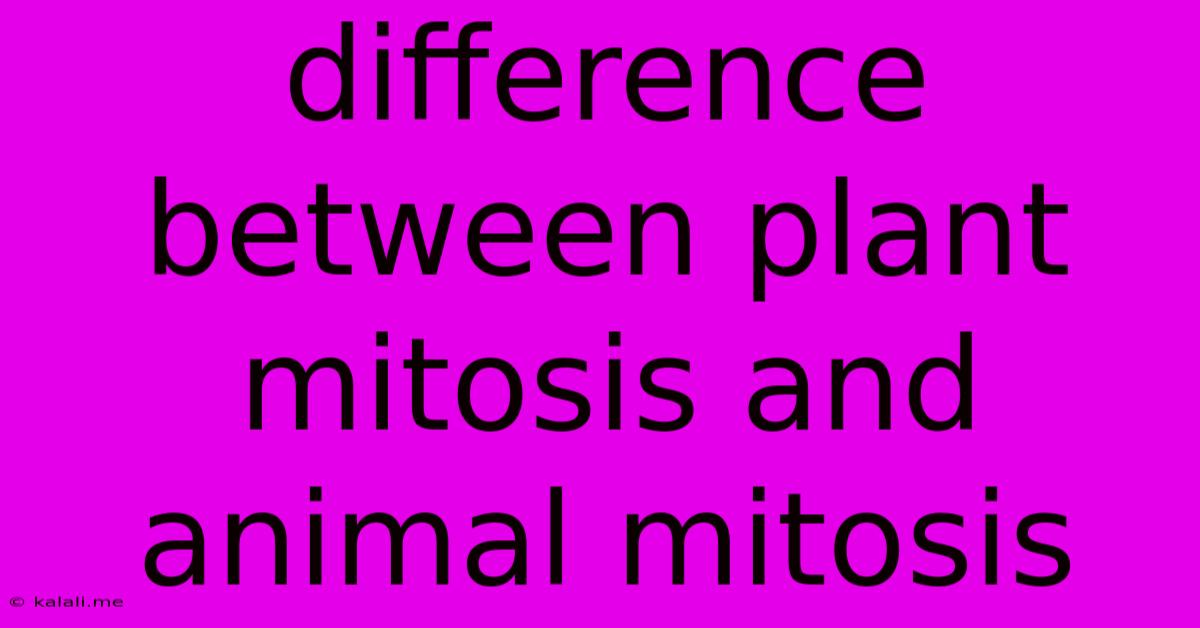Difference Between Plant Mitosis And Animal Mitosis
Kalali
Jun 13, 2025 · 3 min read

Table of Contents
Plant vs. Animal Mitosis: Unveiling the Key Differences
Mitosis, the process of cell division resulting in two identical daughter cells, is fundamental to life. While the basic principles remain the same across organisms, subtle yet crucial differences exist between plant and animal mitosis. Understanding these distinctions provides a deeper appreciation of the complexities of cellular biology and the diverse adaptations of life. This article will delve into the key differences in these fascinating processes.
Key Differences in Plant and Animal Mitosis:
The core differences between plant and animal mitosis primarily lie in the structure of the cells themselves, leading to variations in the processes of cytokinesis (the division of the cytoplasm) and the formation of the cell plate.
1. Cytokinesis: The Defining Difference
Animal cells undergo cytokinesis through a process called cleavage furrow formation. A contractile ring of actin filaments forms beneath the plasma membrane, gradually constricting the cell until it pinches into two separate daughter cells. This is a dynamic process driven by the contraction of the actin filaments. Think of it like tightening a drawstring bag.
Plant cells, on the other hand, possess a rigid cell wall which prevents this type of inward constriction. Instead, cytokinesis involves the formation of a cell plate. This structure begins to form in the center of the cell, growing outwards until it fuses with the existing cell membrane, dividing the cell into two. The cell plate is essentially a new cell wall, built using vesicles originating from the Golgi apparatus, which deliver the necessary materials for its construction. This process is much more structured and less dynamic than cleavage furrow formation.
2. Cell Wall Formation: A Plant-Specific Feature
The presence of a cell wall is a defining characteristic of plant cells, which significantly impacts the cell division process. During plant cytokinesis, the newly formed cell plate eventually develops into a new cell wall, separating the two daughter cells. This process involves the deposition of cellulose and other components to create the sturdy structure of the cell wall. Animal cells lack cell walls and therefore this stage of cell division doesn't occur.
3. Preprophase Band: A Guiding Structure in Plant Cells
Plant cells utilize a structure called the preprophase band before the onset of mitosis. This band of microtubules, positioned just inside the plasma membrane, marks the future plane of cell division. This precise arrangement ensures that the cell plate is formed at the correct location, dividing the cell efficiently and effectively. Animal cells do not exhibit this preprophase band.
4. Location of Centrosomes: Subtle Variations
While both plant and animal cells utilize centrosomes as microtubule organizing centers, their location and behavior differ slightly. In animal cells, centrosomes are typically positioned at opposite poles of the cell, playing a crucial role in spindle fiber formation. In plant cells, centrosomes are less prominent and their function in spindle fiber organization is less pronounced. Other microtubule organizing centers may play a more significant role.
5. Spindle Formation: Similar but with Variations
Both plant and animal cells use a spindle apparatus to separate chromosomes during anaphase. However, the mechanism of spindle formation can differ slightly in details related to the role and location of centrosomes as mentioned above.
Conclusion: Shared Principles, Unique Adaptations
While the fundamental steps of mitosis—prophase, metaphase, anaphase, and telophase—are largely conserved between plant and animal cells, significant variations occur in cytokinesis and associated processes. These variations reflect the unique structural and functional adaptations of plant and animal cells, demonstrating the remarkable diversity of life at the cellular level. Understanding these differences is key to fully appreciating the intricate mechanisms of cell division and their significance in the development and maintenance of multicellular organisms.
Latest Posts
Latest Posts
-
Room Temperature On The Kelvin Scale Is About
Jun 14, 2025
-
Gpa Requirements For Portland State University
Jun 14, 2025
-
First Man Made Plastic Invented In 1862
Jun 14, 2025
-
Average Gpa For Csu Long Beach
Jun 14, 2025
-
Asexual Reproduction Differs From Sexual Reproduction In That
Jun 14, 2025
Related Post
Thank you for visiting our website which covers about Difference Between Plant Mitosis And Animal Mitosis . We hope the information provided has been useful to you. Feel free to contact us if you have any questions or need further assistance. See you next time and don't miss to bookmark.